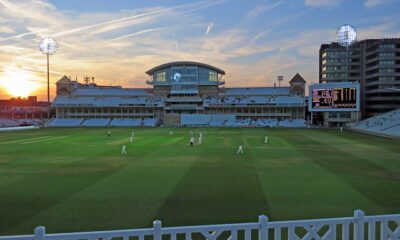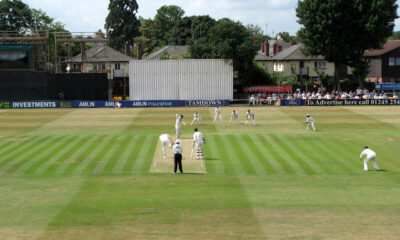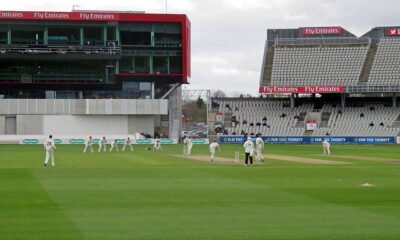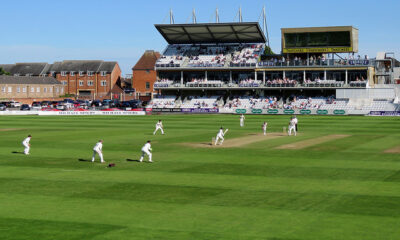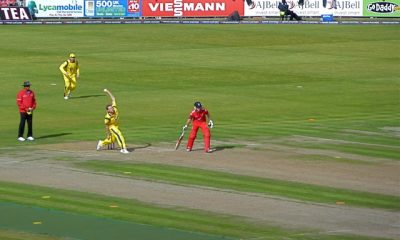Cricket
Takeaways from the World Test Championship

Takeaways from the World Test Championship
The inaugural World Test Championship(WTC) has finally come to an end with New Zealand emerging as the winners. The WTC was a wonderful initiative by the ICC to promote interest in the longest form of the game amidst the boom of T20 leagues across the world. In this article, we look at what worked and what didn’t and what changes can be made to the next cycle to ameliorate the structure.
Test cricket is the first known form of cricket. The first officially recognised Test match took place between 15 and 19 March 1877 and was played between England and Australia at the Melbourne Cricket Ground (MCG). The interest in test cricket has waned over the last decade with the arrival of short form cricket, especially T20 cricket, with leagues across the world, being seen as the next best thing to sliced bread. Test cricket was seen as being too long and in this fast paced world, fans found it tedious to follow or watch the game over the course of 5 days. The test series, save a few like the Ashes, became mundane regular events with not much marketing hype around it leading to decline in importance and consequently, investment. So to address this issue, ICC tried several things to increase viewership and to make the game more appealing to the audience. Day-night cricket being played with a pink ball was one such exercise at innovation with a view to promoting interest. The World Test Championship was established by the ICC was another attempt on the same lines to make a test cricket tournament be the pinnacle for each of the three formats of international cricket.
This championship was first proposed in 2009, when the ICC met the MCC to discuss a proposed Test match championship. Following failed attempts to conduct the Championship in 2013 and 2017, the ICC in October 2017, announced that a Test league had been agreed by its members, which would involve the top nine teams playing series over two years with the top two teams qualifying for a World Test League Championship Final. The first ICC World Test Championship started after the 2019 Cricket World Cup from 1 August 2019, with the Ashes series. The final was contested last week, with New Zealand emerging as the winners.
1. Inequality
| Matches in series | Points for a win | Points for a tie | Points for a draw |
Points for a defeat
|
| 2 | 60 | 30 | 20 | 0 |
| 3 | 40 | 20 | 13 | 0 |
| 4 | 30 | 15 | 10 | 0 |
| 5 | 24 | 12 | 8 | 0 |
The table above shows the points available for a particular match in the World Test Championship based on the length of the series. In order to ensure fairness and parity in the points structure, ICC allocated a maximum of 120 points for every series in the World Test Championship. However, this points structure was not ideal as each team played different number of matches and each match carried different amount of points. For example, a victory in a 2-match series would earn the winner 60 points whereas a victory in a 3,4 or 5 match series would earn the winner lesser number of points. So, this structure benefitted those teams such as New Zealand, Sri Lanka, Bangladesh and West Indies who generally played shorter series compared to the others.
The ICC decided to correct this error by allocating equal points for all matches in the next cycle of the World Test Championship. This is a step in the right direction.
2.Restructuring Due To Pandemic
ICYMI: An altered points system was announced for the World Test Championship following an ICC board meeting yesterday.
The team positions will now be determined by the percentage of points earned ?
Updated #WTC21 standings ? pic.twitter.com/WJmBfeDhxI
— ICC (@ICC) November 20, 2020
As a repercussion of the Covid-19 pandemic, the ICC decided to alter the points structure to make up for the matches that were lost. The ICC decided that the team positions would be determined by the percentage of points obtained(calculated as number of points obtained against the total points available). This put teams like India and Australia who were at the top of the table at a sudden disadvantage. This disappointed Indian captain, Virat Kohli, who remarked that the new points table was “confusing, and very difficult to understand”.
Also, since some series were cancelled, it affected the prospects of some teams depending on whether the series cancelled were home or away. For example, a team like New Zealand had its away series against Bangladesh in less favourable conditions cancelled. So, in effect, some teams played unequal number of series at home and away.
Teams also played disparate number of matches. From the above table, we can see that a team like England have played thrice the number of matches as Bangladesh and almost twice the matches played by New Zealand, West Indies and South Africa.
| Pos | Team | Matches | Won | Lost | Drawn | NR | Points | PCT |
| 1 | India | 17 | 12 | 4 | 1 | 0 | 520 | 72.2 |
| 2 | New Zealand | 11 | 7 | 4 | 0 | 0 | 420 | 70 |
| 3 | Australia | 14 | 8 | 4 | 2 | 0 | 332 | 69.2 |
| 4 | England | 21 | 11 | 7 | 3 | 0 | 442 | 64.1 |
| 5 | Pakistan | 12 | 4 | 5 | 3 | 0 | 286 | 43.3 |
| 6 | West Indies | 11 | 3 | 6 | 2 | 0 | 200 | 33.3 |
| 7 | South Africa | 11 | 3 | 8 | 0 | 0 | 144 | 30 |
| 8 | Sri Lanka | 12 | 2 | 6 | 4 | 0 | 200 | 27.8 |
| 9 | Bangladesh | 7 | 0 | 6 | 1 | 0 | 20 | 0.48 |
3. Outcome Oriented Approach
The World Test Championship succeeded in its attempt to add context to test matches and provide an incentive for the teams to try and play for the win as opposed to being content with draws. It forced the curators to prepare sporting pitches in order to provide results and led to several memorable 4th innings chases during the tournament.
Percentage of drawn test matches in tests since 2000 pic.twitter.com/ZqH1upUjgp
— sk (@sk17535173) June 25, 2021
Percentage of Drawn Test Matches during WTC pic.twitter.com/yvQIdb7Q5C
— sk (@sk17535173) June 25, 2021
| Highest match aggregates(2000-2021) | |||||||||
| Team 1 | Team 2 | Runs | Wkts | Overs | RR | Ground | Match Date | Scorecard | |
| Australia | India | 1747 | 25 | 442.4 | 3.94 | Sydney | 2 Jan 2004 | Test # 1680 | |
| Pakistan | India | 1702 | 28 | 426.4 | 3.98 | Faisalabad | 21 Jan 2006 | Test # 1782 | |
| Australia | New Zealand | 1672 | 28 | 417.5 | 4 | Perth | 13 Nov 2015 | Test # 2187 | |
| South Africa | West Indies | 1648 | 28 | 433.1 | 3.8 | Cape Town | 2 Jan 2004 | Test # 1681 | |
| West Indies | England | 1628 | 17 | 429.0 | 3.79 | Bridgetown | 26 Feb 2009 | Test # 1911 | |
| England | New Zealand | 1610 | 40 | 428.4 | 3.75 | Lord’s | 21 May 2015 | Test # 2162 | |
| India | Pakistan | 1609 | 33 | 431.0 | 3.73 | Bengaluru | 8 Dec 2007 | Test # 1852 | |
| Australia | India | 1606 | 37 | 428.4 | 3.74 | Sydney | 2 Jan 2008 | Test # 1857 | |
| India | Sri Lanka | 1598 | 21 | 436.3 | 3.66 | Ahmedabad | 16 Nov 2009 | Test # 1933 | |
| Bangladesh | Sri Lanka | 1589 | 27 | 437.0 | 3.63 | Chattogram | 4 Feb 2014 | Test # 2117 | |
| England | West Indies | 1576 | 35 | 394.3 | 3.99 | Lord’s | 22 Jul 2004 | Test # 1707 | |
| Australia | India | 1566 | 32 | 392.5 | 3.98 | Adelaide | 9 Dec 2014 | Test # 2148 | |
| England | India | 1558 | 32 | 441.1 | 3.53 | The Oval | 9 Aug 2007 | Test # 1842 | |
| Australia | India | 1550 | 30 | 444.2 | 3.48 | Sydney | 6 Jan 2015 | Test # 2156 | |
| Bangladesh | Sri Lanka | 1533 | 24 | 429.2 | 3.57 | Chattogram | 31 Jan 2018 | Test # 2295 | |
| Bangladesh | West Indies | 1523 | 34 | 421.2 | 3.61 | Dhaka | 13 Nov 2012 | Test # 2057 | |
| Australia | New Zealand | 1522 | 35 | 447.3 | 3.4 | Perth | 30 Nov 2001 | Test # 1573 | |
| Bangladesh | Pakistan | 1515 | 26 | 424.4 | 3.56 | Khulna | 28 Apr 2015 | Test # 2159 | |
| New Zealand | Bangladesh | 1511 | 30 | 397.5 | 3.79 | Wellington | 12 Jan 2017 | Test # 2246 | |
| West Indies | Australia | 1510 | 27 | 407.3 | 3.7 | Port of Spain | 19 Apr 2003 | Test # 1639 | |
| Australia | India | 1508 | 36 | 417.5 | 3.6 | Adelaide | 12 Dec 2003 | Test # 1673 | |
| New Zealand | Bangladesh | 1501 | 32 | 379.3 | 3.95 | Hamilton | 15 Feb 2010 | Test # 1953 | |
| Team 1 | Team 2 | Runs | Wkts | Overs | RR | Ground | Match Date | Scorecard | |
|---|---|---|---|---|---|---|---|---|---|
| India | South Africa | 1447 | 31 | 398.1 | 3.63 | Visakhapatnam | 2 Oct 2019 | Test # 2363 | |
| Australia | India | 1328 | 37 | 399.5 | 3.32 | Brisbane | 15 Jan 2021 | Test # 2404 | |
| Bangladesh | West Indies | 1307 | 35 | 441.5 | 2.95 | Chattogram | 3 Feb 2021 | Test # 2407 | |
| England | Australia | 1291 | 37 | 381.0 | 3.38 | Birmingham | 1 Aug 2019 | Test # 2353 | |
| Sri Lanka | Bangladesh | 1289 | 17 | 385.0 | 3.34 | Pallekele | 21 Apr 2021 | Test # 2418 | |
| India | England | 1285 | 40 | 390.4 | 3.28 | Chennai | 5 Feb 2021 | Test # 2409 | |
| Pakistan | Sri Lanka | 1229 | 33 | 339.1 | 3.62 | Karachi | 19 Dec 2019 | Test # 2375 | |
| Australia | India | 1228 | 31 | 424.2 | 2.89 | Sydney | 7 Jan 2021 | Test # 2402 | |
| South Africa | Sri Lanka | 1197 | 28 | 284.2 | 4.2 | Centurion | 26 Dec 2020 | Test # 2399 | |
| England | Australia | 1181 | 34 | 367.2 | 3.21 | Manchester | 4 Sep 2019 | Test # 2360 | |
| Sri Lanka | Bangladesh | 1165 | 36 | 355.4 | 3.27 | Pallekele | 29 Apr 2021 | Test # 2419 | |
| Australia | Pakistan | 1155 | 30 | 328.2 | 3.51 | Brisbane | 21 Nov 2019 | Test # 2368 | |
| West Indies | Sri Lanka | 1152 | 34 | 422.3 | 2.72 | North Sound | 21 Mar 2021 | Test # 2416 | |
| New Zealand | Pakistan | 1142 | 26 | 324.2 | 3.52 | Christchurch | 3 Jan 2021 | Test # 2400 | |
| South Africa | England | 1131 | 38 | 429.3 | 2.63 | Cape Town | 3 Jan 2020 | Test # 2379 | |
| Australia | Pakistan | 1130 | 23 | 303.4 | 3.72 | Adelaide | 29 Nov 2019 | Test # 2372 | |
| New Zealand | Pakistan | 1121 | 35 | 426.2 | 2.62 | Mount Maunganui | 26 Dec 2020 | Test # 2397 | |
| England | Australia | 1111 | 40 | 328.3 | 3.38 | The Oval | 12 Sep 2019 | Test # 2362 | |
| South Africa | England | 1105 | 40 | 305.3 | 3.61 | Johannesburg | 24 Jan 2020 | Test # 2382 | |
| West Indies | Sri Lanka | 1085 | 26 | 369.5 | 2.93 | North Sound | 29 Mar 2021 | Test # 2417 | |
| England | West Indies | 1083 | 32 | 350.1 | 3.09 | Manchester | 16 Jul 2020 | Test # 2389 | |
| Sri Lanka | New Zealand | 1069 | 34 | 368.5 | 2.89 | Galle | 14 Aug 2019 | Test # 2354 | |
| India | South Africa | 1065 | 25 | 329.3 | 3.23 | Pune | 10 Oct 2019 | Test # 2364 | |
| Australia | New Zealand | 1063 | 31 | 345.4 | 3.07 | Sydney | 3 Jan 2020 | Test # 2378 |
The tables above shows the highest batting total aggregate in a test match since 2000 and during the World Test Championship. We can clearly see from the two tables that the total aggregates have been relatively lower during the WTC as the curators have been inclined to prepare sporting pitches to provide an even contest between the bat and the ball. During an age of big bats, small boundaries and flat pitches, the WTC has provided parity between the batsmen and bowlers.
From the table below, we can see the direct correlation between the bowling averages of teams and their position in the WTC points table. This shows us that the bowlers have had an important role to play during the WTC which is a positive sign.
| TEAM | WICKETS | AVERAGES | STRIKE RATE |
| INDIA | 303 | 22.15 | 45.6 |
| NEW ZEALAND | 193 | 26.99 | 58.3 |
| AUSTRALIA | 246 | 26.17 | 55.9 |
| ENGLAND | 357 | 26.7 | 53.8 |
| PAKISTAN | 143 | 39.32 | 71.8 |
| SRILANKA | 141 | 42.83 | 78.4 |
| WEST INDIES | 167 | 37.44 | 74.4 |
| SOUTH AFRICA | 181 | 34.33 | 60.9 |
4. Format of Finals
The WTC finals was played between June 18th and June 23rd with New Zealand emerging as the winners. Several experts were in favour of the winner being decided over the course of a 3-match test series. Several former players such as Sachin Tendulkar, Ravi Shastri, Krishnamachari Srikkanth were vocal in their support of a 3-match test series to decide the winner. In his post match press conference, Indian captain, Virat Kohli, minced no words and said ” This(3-match test series) definitely has to be brought in. I’m not saying this because we’re not on the winning side, but just for Test cricket and for this saga to be absolutely memorable, it has to happen over a period of three games minimum, so that you have a series to remember. There are going to be ups and downs throughout, with two quality sides going at each other knowing that there’s so much on the line.”
However this would cause several logistical issues for the ICC as well as the test playing nations as it would require all the test playing nations to free up a month in their playing calendar (till the finalists are decided) and this is not possible due to the various T20 leagues and bilateral series taking place across the world.
Best of three next time? #WTCFinal
— ESPNcricinfo (@ESPNcricinfo) June 24, 2021
5. Preparation of pitches
The matches in the World Test Championship were based on already existing bilateral agreements between countries based on the Future Tours Programme (FTP). So, the tours were not organised by the ICC like in the World Cup, World T20 or the Champions Trophy.
The pitches for the World Test Championship were curated by the home curators and not by neutral curators like in the above mentioned tournaments. This meant home teams could doctor pitches according to their strengths. This meant that the home teams had an unfair advantage.
This can be avoided by ensuring that the ICC takes matters into its own hands by organising series between teams and by also appointing neutral curators for matches in the WTC.
All the 12 Test Playing nations were not part of the World Test Championship. Afghanistan, Ireland and Zimbabwe were not part of the WTC. These teams could have given teams like West Indies, Sri Lanka and Bangladesh a run for their money and could have even caused some upsets against the better teams. By not making them a part of the World Test Championship, the ICC has in fact gone against its aim of expanding and marketing test cricket to new countries and to a wider audience by making it more interesting and accessible.
Looking Forward
Looking ahead towards the next cycle, I wish to see the following changes:
-
- Equal matches for all the teams and at both home and away.
- All 12 Test Playing nations being part of the World Test Championship.
- A 2 tier structure(with teams divided into groups of 6) with relegation and promotion to maintain the quality of cricket and to incentivise the teams to perform better.
- Winners being decided over the course of a 3 match test series with a test being played at the home venues of either teams and 1 match at a neutral venue.
We hope you enjoyed the article ‘Takeaways from the World Test Championship.’ What was your favourite moment from the World Test Championship? Let us know!
Read more on cricket here:
- What is ailing cricket in Sri Lanka
- The exponential rise of T20 cricket
- The Highest Paid Cricketers in 2021
-

 News3 weeks ago
News3 weeks agoThe Best Male Tennis Players of All Time
-

 Football3 weeks ago
Football3 weeks agoPlayers with the most goals in a Premier League season
-

 Football1 month ago
Football1 month ago10 of the most underrated footballers in the world right now
-

 News3 weeks ago
News3 weeks agoThe Fastest Rugby Players Ever
-

 Football3 weeks ago
Football3 weeks agoChelsea’s Possible Lineup For Next Season
-

 Football3 weeks ago
Football3 weeks agoWho is the Fastest Football Player in the World?
-

 Football3 weeks ago
Football3 weeks agoThe Best Penalty Takers of All Time
-

 Basketball4 weeks ago
Basketball4 weeks agoThe 5 Biggest NBA trades so far this off-season


